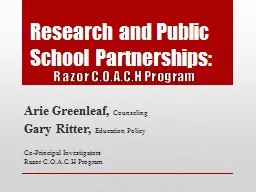

Partnerships Arie Greenleaf Counseling Gary Ritter Education Policy CoPrincipal Investigators Razor COACH Program Razor COACH Program Our Discussion What is the Razor COACH Program Collaboration ID: 784260
Download The PPT/PDF document "Research and Public School" is the property of its rightful owner. Permission is granted to download and print the materials on this web site for personal, non-commercial use only, and to display it on your personal computer provided you do not modify the materials and that you retain all copyright notices contained in the materials. By downloading content from our website, you accept the terms of this agreement.
Slide1
Research and Public School Partnerships:
Arie Greenleaf, CounselingGary Ritter, Education Policy Co-Principal InvestigatorsRazor C.O.A.C.H Program
Razor C.O.A.C.H Program
Slide2Our Discussion
What is the Razor C.O.A.C.H. Program Collaboration?How is the program implemented and evaluated?What are the Razor Coaches doing in our schools?
Slide3The Program
Collaboration between NWAC, COEHP, and local public schools.Funded at $1.5M over 3 years, this program aims to serve at-risk high school students in Washington and Benton Counties.MA students in counseling from the U of A COEHP mentor at-risk students on a weekly basis.
Razor C.O.A.C.H. Program
C
reating
O
pportunities for
A
rkansans’
C
areer
H
opes
Slide4Leadership TeamDr. Kristin Higgins –
Principal Investigator/Project CoordinatorDr. Dan Kissinger – Co-Principal Investigator/Training CoordinatorDr. Arie Greenleaf – Co-Principal InvestigatorDr. Gary Ritter – Co-Principal Investigator/Coordinator of EvaluationJosh Raney – Program Director
Razor C.O.A.C.H. Program - Collaboration
Slide5Implementation and Evaluation
ImplementationHigher demand than anticipatedBig 5 districts 51% FRL and 15% dropout rate (Rural 10 - 53% and 12%)Smaller than average but in a district of 15,000 students, 300 students from each cohort will dropout
Evaluation
Coaches can serve 20-30
Estimated slots 25*15 = 375
Initial applications (targeted 1700, apps to 1400, returned 640)
Random assignment (@ 56%)
Slide6Student Recruitment
ChallengesWant widest possible targets for recruitment, yet can’t serve allNeed consent forms early on in hectic timeSigning up for unknownDifficult to get students to agree to additional supervised time – not really fun!Reluctance with RASchools of varying sizes .. Not one coach per school
Slide7Evaluation Sample – Total Applications Collected =
643 in 16 high schools … minus Wildcards and Sibling Exclusions = 40Final Analytic Sample = 603 in 16 high schoolsParticipant Students = 321 (53%) Control Students = 281
(47%)
Slide8Outcomes for Evaluation
Measures of Student SuccessHigh School GPA Absences Application for Financial Aid Application to Post-Secondary Education ACT Participation and Performance Graduation Rates/Promotion to the Next Grade Attendance at Post-Secondary Education
Some data collected from Students with surveys
Other data collected from School Administrators
Slide9Example Outcome Figure
Figure
x:
Summary
of Coaching
Impact
Slide10Who are Coaches? What will they Do?
15 MA students in Counseling (prestigious fellowships)Applied from various backgrounds from across the countryMost have worked in schools (TFA, counselors, teachers)Will help HS students with: Checking up on academic workOn track toward promotion and graduationAnswer questions about college prep, finances, etc.Answer questions about other post-secondary optionsCaring/Interested adult …. And … information broker
Slide11Other Affective Outcomes
Students get to see the benefits of college through their coachCoaches serve as good role models for studentsStudents will be more comfortable and more likely to relate with coaches given their age
Slide12Day-to-day work of Coaches
Social cognitive career theory (SCCT): theoretical basis for new career coaching model Components of SCCT model: Academic self-efficacyOutcome expectationsPerceived barriers/resourcesS.M.A.R.T goals
Slide13Outcome Expectations
Self-Efficacy
Perceived Supports
Perceived Barriers
More post secondary options
Continued practice of beneficial behavior in college/career
More resiliency
Slide14Academic Self-Efficacy Scale
Slide15Outcome Expectancies Scale
Slide16Perceived Barriers Scale
Slide17SMART Goals
Transition from discussion of Self-Efficacy and Outcome expectations into encouraging students to set goals and helping them do so with this "formula“:Break down the Overall goal into more managable steps
Acknowledge the Barriers that they will have to
overcome
Identify the Motivations
that will keep the student working towards their
goal
Accountability
partners
Slide18Roleplay/Case Study
Low Self-efficacy: Balancing schoolwork with home responsibilities, focusing in class, distractions affect studyingHigh Self-efficacy-feels confident in breaking down large assignments into smaller one, strong motivation, confident in talking to someone working in her desired occupation. Outcome Expectancy-believes when motivated you can accomplish more, studying is beneficial, gpa will affect how she performs in her career
Perceived/Real Barriers: Time Barriers, focus on time management, not having a place to study, transportation barrier
What should we work on?
Supports, goals, motivational factors, bridges to perceived barriers
Slide19Research and Public School Partnerships:
THANK YOU!
Razor C.O.A.C.H Program